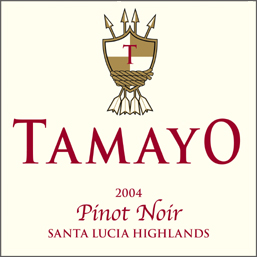

Tamayo Family Vineyards
2004 Pinot Noir, Sleepy Hollow Ranch(Santa Lucia Highlands)
Santa Lucia Highlands began turning Pinot Noir on its ear about five years ago with big, tannic, alcoholic wines that more resembled Syrah. Now, some growers and producers up there in the western hills of Monterey County have gotten a hold of themselves and began taming the wines to taste like Pinot Noir – albeit Pinot Noir that is still bigger and more powerful than wines from the Russian River, Anderson Valley and the Carneros.
The Tamayo family, with the help from consulting winemaker Charles Hendricks, has gone to Robert Talbott’s Sleepy Hollow Ranch Vineyard to make this wonderfully characterful Pinot. Hendricks, who has his own Hope & Grace brand, has also consulted for Viader, Barnett, Regusci, Paoletti and Bacio Divino – all in the Napa Valley.
He’s fashioned this Tamayo Pinot to be redolent of dried cherries and sweet plums which linger. While it’s lighter than most SLH Pinots, one can still discern that it has decidedly mountain fruit. It’s drinking nicely now and will do so over the next six years.
Some of the grapes for this wine came from 37-year-old vines which have been modernized under the tutelage of Talbott for the last dozen years. The wine spent 14 months in French oak, the stated alcohol is 14.2 percent, and there were only 200 cases produced.
Reviewed August 3, 2007 by Alan Goldfarb.
Other reviewed wines from Tamayo Family Vineyards
|
Tamayo Family Vineyards 2003 Cana Cabernet Sauvignon, Logan's Run (Napa Valley)Catherine Fallis 8/2/2007 |
The Wine
Winery: Tamayo Family Vineyards |
The Reviewer Alan Goldfarb
Alan Goldfarb
Alan Goldfarb has been writing about and reviewing wine for 17 years. His reviews have been published in the St. Helena Star, San Jose Mercury, San Francisco Examiner, Decanter, and Wine Enthusiast, among others. Not once has he used a point system, star system, or an iconic symbol to quantify a wine. What counts in Mr. Goldfarb’s criteria when judging a wine is: how it tastes in the glass; is it well-constructed; its food compatibility; and presence of redeeming regional attributes. |













